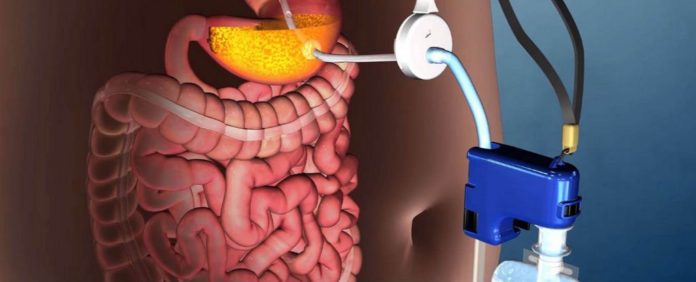
There is sort of good news for obese people struggling to shed those extra pounds through military-training-like dieting, or equally strenuous exercise. The U.S. Food and Drug Administration has just approved AspireAssist — a new weight-loss device that sucks undigested food directly from the stomach into a nearby toilet after every meal. This is aimed “for patients aged 22 and older who are obese, with a body mass index of 35 to 55, and who have failed to achieve and maintain weight loss through non-surgical weight-loss therapy.”
The controversial ‘weight-loss aid’ being marketed as a cheaper, easier, and less invasive treatment than bariatric surgery, aims to control the amount of calories by removing a third of what you eat before your intestine had time to digest and absorb it. William Maisel, deputy director for science and chief scientist at the FDA’s Centre for Devices and Radiological Health, said in a statement:
“The AspireAssist approach helps provide effective control of calorie absorption, which is a key principle of weight management therapy. Patients need to be regularly monitored by their health-care provider and should follow a lifestyle program to help them develop healthier eating habits and reduce their calorie intake.”
The FDA reviewed results from a clinical trial of 171 obese patients, wherein 111 patients received lifestyle therapy along with the AspireAssist; and a 60-patientcontrol group received lifestyle therapy without the AspireAssist. The trial started in February of 2012 and after one year, the AspireAssist group lost an average of 12.1% of their total body weight, while the control group lost an average of 3.6% of their total body weight.
The FDA explains the procedure:
“To place the device, surgeons insert a tube in the stomach with an endoscope via a small incision in the abdomen. A disk-shaped port valve that lies outside the body, flush against the skin of the abdomen, is connected to the tube and remains in place. Approximately 20 to 30 minutes after meal consumption, the patient attaches the device’s external connector and tubing to the port valve, opens the valve and drains the contents. Once opened, it takes approximately five to 10 minutes to drain food matter through the tube and into the toilet. The device removes approximately 30 percent of the calories consumed.”
We began the article with calling AspireAssist ‘sort of’ good news because while the revolutionary device seems incredible for most in-need patients, there is a lot that can go wrong during and after the procedure. With a warning that AspireAssist should not be used on patients with eating disorders, and that it is not intended to be used for short durations in those who are moderately overweight, the FDA warns:
“The endoscopic surgical placement of the gastric tube is associated with risks, including sore throat, pain, abdominal bloating, indigestion, bleeding, infection, nausea, vomiting, sedation-related breathing problems, inflammation of the lining of the abdomen, sores on the inside of the stomach, pneumonia, unintended puncture of the stomach or intestinal wall and death.
“Risks related to the abdominal opening for the port valve include abdominal discomfort or pain, irritation, hardening or inflammation of the skin around the site where the tube is placed, leakage, bleeding and/or infection around the site where the tube is placed and device migration into the stomach wall. All have the potential to necessitate removal of the device. After device removal, there may be a risk of persistent fistula, an abnormal passageway between the stomach and the abdominal wall.
“AspireAssist is contraindicated in those with certain conditions, including uncontrolled hypertension, diagnosed bulimia, diagnosed binge eating disorder, night eating syndrome, certain types of previous abdominal surgery, pregnancy or lactation, inflammatory bowel disease or stomach ulcers. AspireAssist is also contraindicated in patients with a history of serious pulmonary or cardiovascular disease, coagulation disorders, chronic abdominal pain or those at a high risk of medical complications from an endoscopic procedure.
“Side effects related to use of the AspireAssist include occasional indigestion, nausea, vomiting, constipation and diarrhea.”
Even as the FDA insists AspireAssist is not a bulimia assist, AspireAssist does seem like a bulimia machine carefully supervised by medical professionals. Keith Ayoob, an associate clinical professor of nutrition at Albert Einstein College of Medicine in New York City told ABC News that he was horrified by the AspireAssist, but he’s not surprised it was invented.
“People often wish they could just eat and make the calories go away. It was only a matter of time before someone came up with this. This is an enabling device, not a helping device. It doesn’t do anything to make someone change their relationship with food. Once you put this in someone, they’re never going to want it taken out.”
However, Pennsylvania-based Aspire Bariatrics, developer of AspireAssist, has an explanation to counter critics:
“Bulimia is a psychological illness characterized by excessive and uncontrolled binging episodes followed by purging. Bulimia is medically unsupervised, while the AspireAssist is used under the control of a physician and electrolytes and metabolites are carefully monitored. The AspireAssist does not cause bulimia. Successful aspiration requires careful chewing and slower eating, which is quite opposite from an uncontrolled binging episode. One of the primary dangers of bulimia is the damage to the teeth and esophagus due to stomach acid; the AspireAssist poses no such risk.”
Is AspireAssist a curse or a blessing? Who guarantees that a temporary solution for morbid obesity would not be disastrous in the long run? Do you find the idea of the pump gross? Please share your thoughts in the comments section below…
This article (FDA Approves Controversial Weight-Loss Device that Drains Food Directly From Stomach into Toilet) is a free and open source. You have permission to republish this article under a Creative Commons license with attribution to the author and AnonHQ.com.




